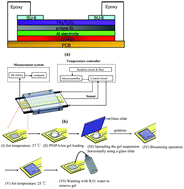In this study, we report an electrolyte–insulator–semiconductor (EIS) device with a novel high-k Tm2Ti2O7 sensing membrane for pH detection. In this research, the sensing membrane was fabricated by reactive sputtering and postdeposition annealing treatment. The effect of thermal annealing (700, 800, and 900 °C) on the structural and surface properties of the Tm2Ti2O7 sensing membrane was investigated by X-ray diffraction, secondary ion mass spectrometry, X-ray photoelectron spectroscopy, and atomic force microscopy. The observed properties were then correlated with the resulting EIS pH sensing performances. The results disclosed that the pH sensing based on the EIS structure with the sensing membrane annealed at the higher temperature of 900 °C showed a higher detection sensitivity (59.38 mV pH−1), smaller hysteresis voltage (2.4 mV), and lower signal drifting rate (0.568 mV h−1), compared with those annealed at a lower annealing. These results are attributed to the formation of a crystalline oxide thin film with a rougher surface in this condition. Moreover, for EIS-based biosensing applications, a phase tunable poly-N-isopropylacrylamide (PNIPAAm) was used as an enzyme encapsulating material in this study, making the loading and removal of a biological recognition element on a biosensor easy. In this work, a hybrid configuration of the proposed Tm2Ti2O7 membrane-EIS with glucose oxidase-immobilizing PNIPAAm film attached was established and was demonstrated for glucose biosensing. Results demonstrated that the proposed biosensor was able to detect glucose with good linearity (R2 = 0.99) and reasonable sensitivity of 14.66 mV mM−1 in the glucose concentration range of 2–8 mM. Overall, the presented work has provided some fundamental data on the use of Tm2Ti2O7 sensing membrane for EIS-based pH detection, and has also demonstrated the feasibility of using the PNIPAAm to encapsulate enzyme molecules for the biosensing applications.


 Please wait while we load your content...
Please wait while we load your content...